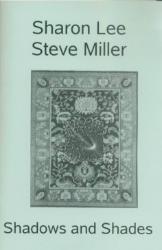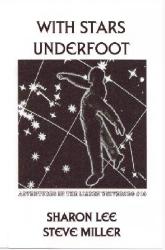"Heirloom" in Shadows and Shades (#8)
"Veil of the Dancer" in Quiet Knives (#9)
"Quiet Knives" in Quiet Knives (#9)
"This House" in With Stars Underfoot (#10)
 In "Naratha’s Shadow," the first story in Shadows and Shades (#8), a Soloesque space merchant named Montet is trying to unload an ancient artifact that confounds the psionic Healers, who seem to be the wise men and women of the Liaden universe. In spite of their begging her to drop the box into a nova, because of its H.P. Lovecraft vibes, Montet traces the artifact to its homeworld. The artifact turns out to be both more and less than it appears. You can see the explanation coming but the story is enjoyable for all that, especially for its tight, well-wrought prose, economical characterization, and basically charitable vision of humanity—characteristics I found in all of these stories.
In "Naratha’s Shadow," the first story in Shadows and Shades (#8), a Soloesque space merchant named Montet is trying to unload an ancient artifact that confounds the psionic Healers, who seem to be the wise men and women of the Liaden universe. In spite of their begging her to drop the box into a nova, because of its H.P. Lovecraft vibes, Montet traces the artifact to its homeworld. The artifact turns out to be both more and less than it appears. You can see the explanation coming but the story is enjoyable for all that, especially for its tight, well-wrought prose, economical characterization, and basically charitable vision of humanity—characteristics I found in all of these stories. Quiet Knives (#9) opens with "Veil of the Dancer," a fable set in a Taliban-like society, told in a style reminiscent of the Thousand and One Nights. A man with three daughters marries off the first two in the prescribed manner, but treats the third rather differently: he secretly teaches her to read. The multicultural nature of the presumably Terran-descended parts of the universe is nicely hinted at throughout, and despite the authors’ forgiving view of people, they can create nasty villains when they want to. The same is true of the title story, in which another Soloesque space pilot makes good on a promise long forgotten, to a man she thinks betrayed her. Of the six stories under consideration, it’s the closest to action-adventure, and a satisfying one at that. It even has nonhuman aliens.
 With Stars Underfoot (#10) opens with "This House," originally published in the recent Janis Ian tribute anthology. (Can there be one for Aimee Mann, and if so can I have dibs on "Fifty Years After the Fair"?) It’s another story of a character imposed on to do a good turn for somebody who he thinks did him the opposite years ago, and almost silently slips past the reader the information that the Liaden universe is a blue state as far as tolerance for sexual preferences goes. The Healer’s dilemma—help a lover who abandoned him fill the gaps in her memory, even though the only thing she has forgotten is her present companion—is a poignant one, and the peculiar memory loss is actually presented in a believable if spooky manner.
With Stars Underfoot (#10) opens with "This House," originally published in the recent Janis Ian tribute anthology. (Can there be one for Aimee Mann, and if so can I have dibs on "Fifty Years After the Fair"?) It’s another story of a character imposed on to do a good turn for somebody who he thinks did him the opposite years ago, and almost silently slips past the reader the information that the Liaden universe is a blue state as far as tolerance for sexual preferences goes. The Healer’s dilemma—help a lover who abandoned him fill the gaps in her memory, even though the only thing she has forgotten is her present companion—is a poignant one, and the peculiar memory loss is actually presented in a believable if spooky manner.
The other story, "Lord of the Dance," is something of a cast-members reunion, and, predictably, the one I found hardest to follow. The pretext for getting these people together is one of those seasonal balls that feature so often in Regency novels, and the dance itself helps Pat Rin get the bearings he needs to pass his pilot exam.
So if it might have helped me to have read more deeply in these series, my ignorance didn’t prevent me from enjoying these stories. The craftsmanship and love that clearly went into them makes them easy to read, the way a well-made chair feels good to sit on. There’s an element of wish-fulfillment in these stories, but the wish is to reach some kind of meaningful understanding with a strange or estranged Other. It’s one of the great themes of science fiction, and it’s a wish well worth having.
Chapbook: $10.00 ea